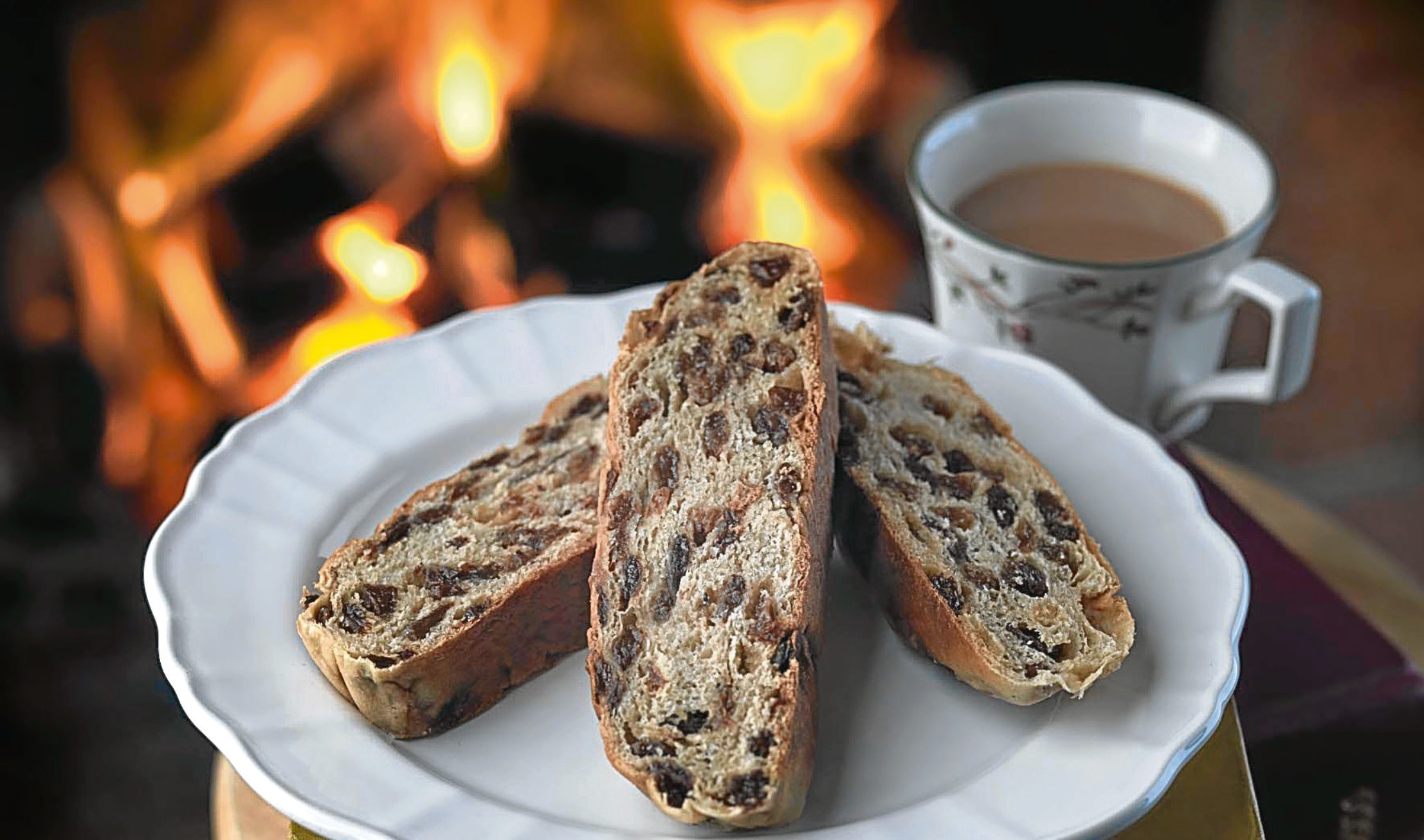I bought a Selkirk bannock in our favourite farm shop in deepest Aberdeenshire. Seeing it lying in a basket brought back childhood memories of visiting my Loanhead aunties (outside Edinburgh) who often had it on the table for high tea.
The bannock was far from its traditional heartland and I felt I owed it to my aunties’ memory to buy it. Anyhow, it’s one of those cholesterol treats that are hard to resist for it is best eaten with a generous spreading of salt butter.
Selkirk bannocks have a long Borders’ pedigree. Sir Walter Scott wrote of them in The Bride of Lammermoor, published in 1819 – “never such a making of car cakes and sweet scones, Selkirk Bannocks, cookies and petticoat tails, delicacies little known to the present generation”. I suspect he would say much the same about today’s generation.
They have no connection with bannocks, or oatcakes, which are made with oatmeal and traditionally should be cooked on a girdle. Selkirk bannocks are a sweet tea bread cooked in a “good, steady oven”. In that staple of Scottish cookery books – The Scots Kitchen, by F. Marian McNeill – her recipe includes baker’s dough, butter, lard, sugar, three-quarters of a pound of sultanas and candied orange peel. What you might call a cholesterol fix.
When I was at school near Edinburgh, one of my Loanhead uncles’ treats was to bring me tins of Jethart snails from Jedburgh. I don’t know if they are made any longer but they were sticky boilings – boiled sugar sweeties that took ages to sook until they were all gone.
They must have had a very sweet tooth in the Borders, or maybe it was just my Loanhead uncle, for I remember getting minty Hawick Balls and Moffat toffee too. And there were Berwick Cockles – soft, creamy sweeties made in the shape of cockleshells.
Calorie counting
I wondered what my home town of Montrose could offer the regional palate. Marian McNeill has a recipe for Montrose cakes, made to Mrs Dalgairn’s recipe. I never met the good lady and her cakes have never graced any tea table I’ve tucked my knees under. Can it be the brandy and the rosewater in the recipe? Are 12 eggs and three-quarters of a pound of currants excessive? Or do a pound of fresh butter and a pound of sugar loaf blow the good calorie test wide open?
Maybe the problem lay with the instruction to beat all the ingredients “well together for twenty to thirty minutes”. In Marian McNeill’s day they would have done it by hand. With today’s electric mixers this could be the time for a revival.
“Man is a cooking animal” are the opening words of The Scots Kitchen. Scotland has an enviable range of regional delicacies and Courier Country and the north-east have their fair share. It’s no real surprise I cast a generous shadow when I think of the Forfar bridies I’ve consumed. I don’t suppose the Dundee cake has helped and perhaps it’s best not to mention the Aberdeen butteries.
On the other hand there surely can’t be a word against Arbroath smokies. Simple, unadorned North Sea haddock, hot-smoked over oak chip embers which cook and give the fish its delicate smoked taste, ready to eat straight off the barrel, as they say in Arbroath.
Cullen Skink – properly, it should be made with a Finnan Haddie which are difficult to find these days, but a smokie will do – would pass the good calorie test if it wasn’t for the lashings of cream that are an essential ingredient. But what a truly sublime dish – a meal on its own – with the fish flaked through it and served with well-buttered slices of sensible brown bread.
Floral favourites
A great favourite of my mother’s was Kirriemuir gingerbread, which benefits from a spread of butter, too. An old lady used to make it for her and she must have used nearly a tin of black treacle in each one for it was dark, sticky and gloriously calorie-endowed.
Don’t make the mistake of asking in the butcher’s for Kirrie Dumplings. You’ll get some funny looks and be directed to the local garden centre. Primula denticulata – or Drumstick Primulas, pompoms of lilac florets which provide spring nectar for early flying butterflies and bumble bees – are affectionately known in Courier country as Kirrie Dumplings.
Haggis, black pudding, Tunnock’s Chocolate Caramel Wafers – even today there’s no end to Scotland’s culinary bounty.
If you’re walking dogs every day, it’s essential to go out fortified against the worst the weather can throw at you, especially as autumn draws into winter. The old recipes have stood the test of time because they convey a sense of inner peace and fulfilment. The good news is that the walk will burn off those tiresome calories.
I couldn’t end without telling the story of the wee boy who was given Cumberland sausage for his tea. “Did you enjoy that, dear?” inquired his auntie. The wee lad looked confused. “Where was the Cumble?” he asked!
Don’t Miss The Whitsons’ Kitchen – Angus and the Doyenne’s take on The Great British Bake Off – every Wednesday in The Courier.


